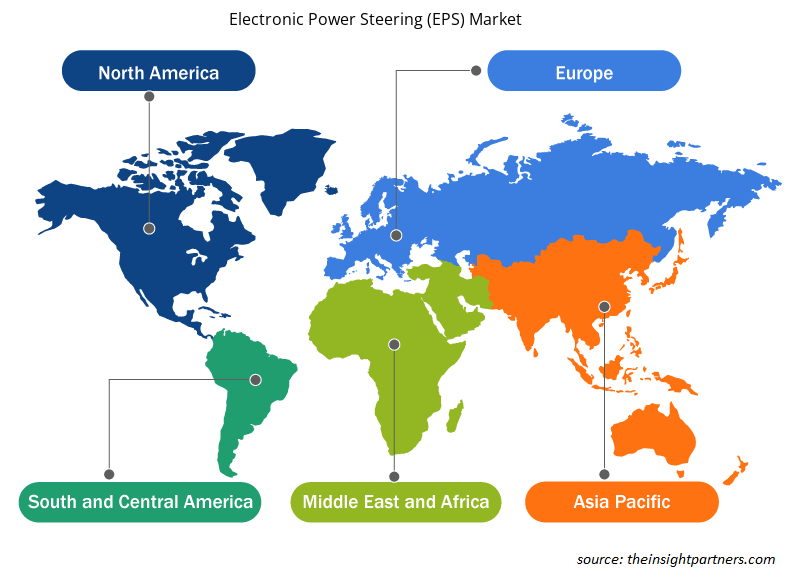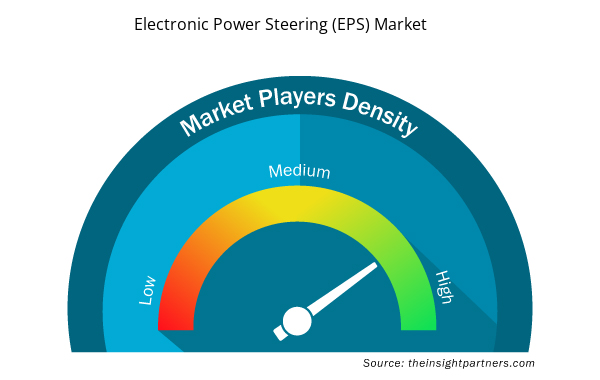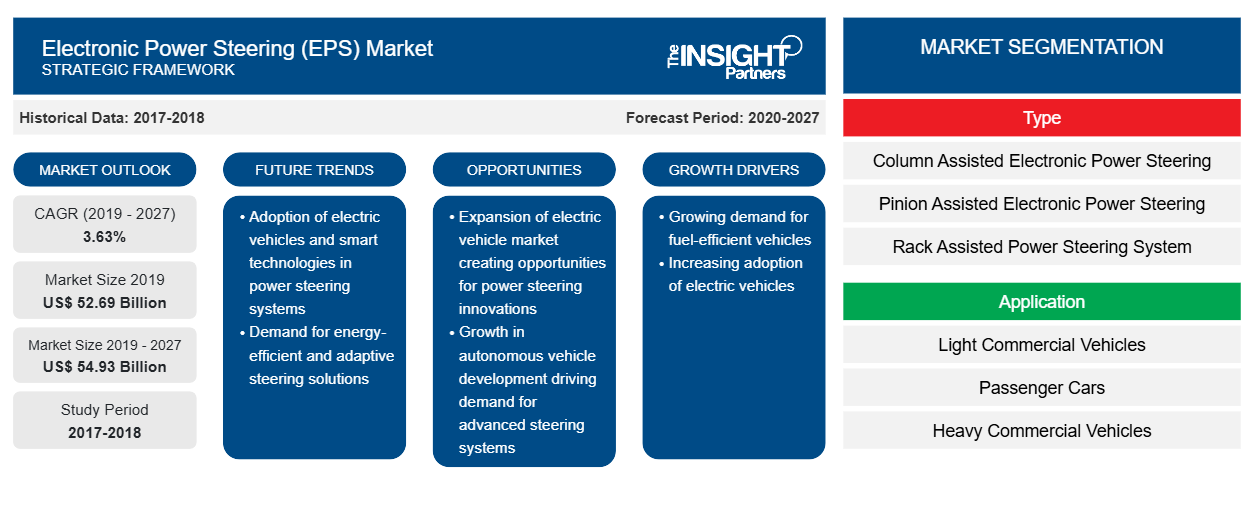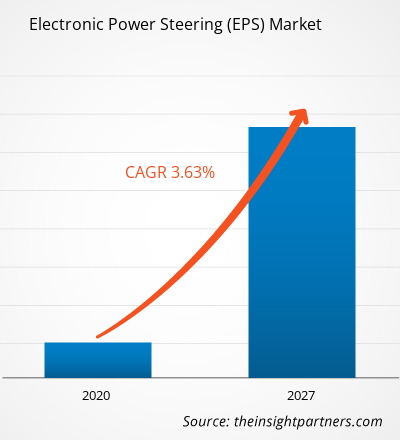2019 年全球电子助力转向市场价值为 526.9231 亿美元,预计在 2020 年至 2027 年的预测期内复合年增长率为 3.63%。
电子助力转向市场大致分为五大区域——北美、欧洲、亚太地区、中东和非洲以及南美地区。2019 年,全球市场由亚太地区主导,由于对电子助力转向系统的需求较高,该地区占总市场的近一半。亚太地区人口更广泛地采用高档汽车、轿车和 SUV 等因素,显著促进了该地区更大的市场份额。此外,福特汽车公司澳大利亚有限公司、丰田汽车公司澳大利亚有限公司、三菱汽车澳大利亚有限公司 (MMAL)、通用汽车霍顿、五十铃澳大利亚有限公司、大众汽车集团澳大利亚有限公司和现代商用车澳大利亚有限公司是该国一些知名的商用车制造商。所有这些制造商都要求在汽车中集成 EPS,以满足客户的新兴需求。此外,汽车制造业务的不断升级、电动汽车需求的不断增长以及 EPS 制造商对提供低成本、高效率产品的日益关注,预计将在预测期内推动亚太地区其他国家EPS 市场的增长。
市场洞察——电子助力转向市场
中国高档汽车销量不断增长
定制此报告以满足您的需求
您可以免费定制任何报告,包括本报告的部分内容、国家级分析、Excel 数据包,以及为初创企业和大学提供优惠和折扣
- 获取此报告的关键市场趋势。这个免费样品将包括数据分析,从市场趋势到估计和预测。
2019 年,中国汽车销量接近 2140 万辆。该国是全球最大的汽车生产国和最大的汽车销售市场。尽管如此,2019 年整体汽车销量下降了约 1.9%,但与 2018 年相比,对 SUV 和高档轿车的需求分别增长了 3.5% 和 18.8%。包括宝马、奔驰和奥迪在内的中国所有主要豪华车 OEM 都在 2019 年 11 月报告了积极的数据。随着销量的增长,市场格局也发生了迅速变化。在上一代人中,消费者购买高档汽车主要是为了彰显自己的社会地位,但日益成熟的新一代买家购买高档汽车是为了满足对豪华和智能技术的需求。根据中国汽车工业协会的一项研究,女性在中国高档汽车市场中扮演着重要角色。调查显示,女性在选择车型时更看重安全性、舒适性和外观造型,而男性则更看重动力系统技术、社会认可的高端品牌和更大的车型。上述因素将推动轿车和 SUV 集成 EPS 的需求。
COVID-19的影响
半导体和汽车行业是 COVID-19 的受害者之一,自 2020 年初以来,这些行业一直呈现下滑趋势。随着北美、欧洲和亚洲各国实施封锁,这些行业经历了令人震惊的经历。汽车行业需要大量人力,而 COVID-19 病毒通过人类参与传播,该行业无法正常运作。汽车和半导体行业的下滑趋势对电子助力转向市场产生了负面影响。
类型细分洞察
根据类型,柱式辅助电子动力转向器在 2019 年占据了全球电子动力转向器市场的主导地位。电子动力转向系统正在逐渐取代现代车辆中的传统转向系统。使用电子动力转向系统的主要好处是能够最大限度地降低能耗。柱式辅助电子动力转向 (C-EPS) 系统是电子动力转向系统的一种类型。
车辆类型细分洞察
根据车辆类型,乘用车领域在 2019 年全球电子助力转向市场中占有最大份额。乘用车是座位数不超过 8 的运输车辆。由于孟加拉国、巴基斯坦、蒙古、阿富汗、印度等国家的天气和空气质量恶化,人们在乘用车中采用替代燃料和相关技术。乘用车可分为轿车、掀背车和 SUV 或 MUV。随着人均收入和奢侈品需求的增加,对乘用车的需求也在增加。
市场参与者专注于新产品的创新和开发,通过在其产品中集成先进的技术和功能来与竞争对手竞争。
- 2019 年,耐世特汽车宣布其全球电动助力转向 (EPS) 系统产量已达 6000 万辆。该系统可用于从小型车到大型卡车的各种车辆。电动助力转向系统可将燃油效率提高 6%,二氧化碳排放量每公里减少 8 克。
- 2018 年,罗伯特·博世有限公司在玛莎拉蒂 2018 款车型的所有车型上都安装了博世高速公路辅助系统,以实现部分自动驾驶功能。除此之外,玛莎拉蒂 2018 款车型上推出的另一项创新是博世电动助力转向系统 (EPS),它为高速公路辅助技术和其他高级驾驶辅助系统的实施做出了贡献。
- 2018年,现代摩比斯开发出了一种电动助力转向系统,该系统在自动驾驶过程中利用两个电子电路,以便在任何情况下都能保持正常的转向能力。
电子助力转向
电子助力转向 (EPS) 市场区域洞察
Insight Partners 的分析师已详细解释了预测期内影响电子动力转向 (EPS) 市场的区域趋势和因素。本节还讨论了北美、欧洲、亚太地区、中东和非洲以及南美和中美洲的电子动力转向 (EPS) 市场细分和地理位置。

- 获取电子动力转向 (EPS) 市场的区域特定数据
电子助力转向 (EPS) 市场报告范围
| 报告属性 | 细节 |
|---|---|
| 2019 年市场规模 | 526.9 亿美元 |
| 2027 年市场规模 | 549.3亿美元 |
| 全球复合年增长率(2019 - 2027) | 3.63% |
| 史料 | 2017-2018 |
| 预测期 | 2020-2027 |
| 涵盖的领域 | 按类型
|
| 覆盖地区和国家 | 北美
|
| 市场领导者和主要公司简介 |
|
电子助力转向 (EPS) 市场参与者密度:了解其对业务动态的影响
电子助力转向 (EPS) 市场正在快速增长,这得益于终端用户需求的不断增长,而这些需求又源于消费者偏好的不断变化、技术进步以及对产品优势的认识不断提高等因素。随着需求的增加,企业正在扩大其产品范围,进行创新以满足消费者的需求,并利用新兴趋势,从而进一步推动市场增长。
市场参与者密度是指在特定市场或行业内运营的企业或公司的分布情况。它表明在给定市场空间中,相对于其规模或总市场价值,有多少竞争对手(市场参与者)存在。
在电子动力转向 (EPS) 市场运营的主要公司有:
- 现代摩比斯
- JTEKT 公司
- 三菱电机公司
- 耐世特汽车
- 日本精工株式会社
免责声明:上面列出的公司没有按照任何特定顺序排列。

- 获取电子动力转向 (EPS) 市场顶级关键参与者概览
全球电子助力转向市场细分如下:
电子动力转向市场 – 按类型
- 转向柱助力电子助力转向
- 小齿轮辅助电子动力转向
- 齿条助力转向系统
- 电子液压动力转向
电子动力转向市场 – 按车型
- 轻型商用车
- 乘用车
- 重型商用车
电子助力转向市场- 区域分布
北美
- 我们
- 加拿大
- 墨西哥
欧洲
- 法国
- 德国
- 意大利
- 英国
- 俄罗斯
- 欧洲其他地区
亚太地区 (APAC)
- 中国
- 印度
- 韩国
- 日本
- 澳大利亚
- 亚太地区其他地区
中东和非洲 (MEA)
- 南非
- 沙特阿拉伯
- 阿联酋
- MEA 其他地区
南美洲 (SAM)
- 巴西
- 阿根廷
- SAM 其余部分
电子动力转向市场 – 公司简介
- 现代摩比斯
- JTEKT 公司
- 三菱电机公司
- 耐世特汽车
- 日本精工株式会社
- 罗伯特·博世有限公司
- 昭和公司
- 万都公司
- 蒂森克虏伯股份公司
- 采埃孚股份公司
- 历史分析(2 年)、基准年、预测(7 年)及复合年增长率
- PEST 和 SWOT 分析
- 市场规模价值/数量 - 全球、区域、国家
- 行业和竞争格局
- Excel 数据集



Report Coverage
Revenue forecast, Company Analysis, Industry landscape, Growth factors, and Trends

Segment Covered
This text is related
to segments covered.

Regional Scope
North America, Europe, Asia Pacific, Middle East & Africa, South & Central America

Country Scope
This text is related
to country scope.
常见问题
The electronic power steering (EPS) market is led by passenger cars segment with highest share and is expected to dominate in the forecast period. Passenger cars are the transport vehicles with not more than eight seats. Due to the worsening weather and air quality in countries, such as Bangladesh, Pakistan, Mongolia, Afghanistan, India, people are adopting alternative fuel and related technologies in their passenger cars. Passenger cars can be divided into sedan, hatchback, and SUV or MUV. The demand for passenger vehicles is increasing with a rise in per capita income and need for luxury. The electronic power steering system is linked to the vehicle control unit.
There is an increase in adoption of buses and trucks, specifically for logistics and public transportation purposes, across the globe. In Asia, Oceania, and Europe, the public transportation is used more as compared to private transportation, whereas in North America, transportation is mainly through private vehicles. Growing population in urban areas is demanding the increasing public transportation with the improvement in existing transportation infrastructure is proving to be insufficient. The OEMs across the globe are now focusing on reducing the global carbon footprint, therefore, boosting the usage of electric vehicles is anticipated to offer ample growth opportunities for the global electronic power steering (EPS) market players.
Rising adoption of autonomous driving worldwide is one of the major factors boosting the adoption of steer-by-wire systems in the vehicles. SbW is enhancing the driving experience as well as safety. The SbW technology is currently experiencing a constant surge in development as well as demand. The higher levels of autonomous driving require uninterrupted communication, redundant power supply, and steering rack. Moreover, the SbW enhances the safety with the help of driver assistance systems. It also eliminates the intermediate steering shaft and thus, reduces the risk of injury to the driver from mechanical steering components by augmenting the passive safety in the vehicle.
Trends and growth analysis reports related to Automotive and Transportation : READ MORE..
The List of Companies - Electronic Power Steering Market
- Hyundai Mobis
- JTEKT Corporation
- Mitsubishi Electric Corporation
- Nexteer Automotive
- NSK Ltd.
- Robert Bosch GmbH
- Showa Corporation
- The Mando Corporation
- ThyssenKrupp AG
- ZF Friedrichshafen AG
The Insight Partners performs research in 4 major stages: Data Collection & Secondary Research, Primary Research, Data Analysis and Data Triangulation & Final Review.
- Data Collection and Secondary Research:
As a market research and consulting firm operating from a decade, we have published and advised several client across the globe. First step for any study will start with an assessment of currently available data and insights from existing reports. Further, historical and current market information is collected from Investor Presentations, Annual Reports, SEC Filings, etc., and other information related to company’s performance and market positioning are gathered from Paid Databases (Factiva, Hoovers, and Reuters) and various other publications available in public domain.
Several associations trade associates, technical forums, institutes, societies and organization are accessed to gain technical as well as market related insights through their publications such as research papers, blogs and press releases related to the studies are referred to get cues about the market. Further, white papers, journals, magazines, and other news articles published in last 3 years are scrutinized and analyzed to understand the current market trends.
- Primary Research:
The primarily interview analysis comprise of data obtained from industry participants interview and answers to survey questions gathered by in-house primary team.
For primary research, interviews are conducted with industry experts/CEOs/Marketing Managers/VPs/Subject Matter Experts from both demand and supply side to get a 360-degree view of the market. The primary team conducts several interviews based on the complexity of the markets to understand the various market trends and dynamics which makes research more credible and precise.
A typical research interview fulfils the following functions:
- Provides first-hand information on the market size, market trends, growth trends, competitive landscape, and outlook
- Validates and strengthens in-house secondary research findings
- Develops the analysis team’s expertise and market understanding
Primary research involves email interactions and telephone interviews for each market, category, segment, and sub-segment across geographies. The participants who typically take part in such a process include, but are not limited to:
- Industry participants: VPs, business development managers, market intelligence managers and national sales managers
- Outside experts: Valuation experts, research analysts and key opinion leaders specializing in the electronics and semiconductor industry.
Below is the breakup of our primary respondents by company, designation, and region:

Once we receive the confirmation from primary research sources or primary respondents, we finalize the base year market estimation and forecast the data as per the macroeconomic and microeconomic factors assessed during data collection.
- Data Analysis:
Once data is validated through both secondary as well as primary respondents, we finalize the market estimations by hypothesis formulation and factor analysis at regional and country level.
- Macro-Economic Factor Analysis:
We analyse macroeconomic indicators such the gross domestic product (GDP), increase in the demand for goods and services across industries, technological advancement, regional economic growth, governmental policies, the influence of COVID-19, PEST analysis, and other aspects. This analysis aids in setting benchmarks for various nations/regions and approximating market splits. Additionally, the general trend of the aforementioned components aid in determining the market's development possibilities.
- Country Level Data:
Various factors that are especially aligned to the country are taken into account to determine the market size for a certain area and country, including the presence of vendors, such as headquarters and offices, the country's GDP, demand patterns, and industry growth. To comprehend the market dynamics for the nation, a number of growth variables, inhibitors, application areas, and current market trends are researched. The aforementioned elements aid in determining the country's overall market's growth potential.
- Company Profile:
The “Table of Contents” is formulated by listing and analyzing more than 25 - 30 companies operating in the market ecosystem across geographies. However, we profile only 10 companies as a standard practice in our syndicate reports. These 10 companies comprise leading, emerging, and regional players. Nonetheless, our analysis is not restricted to the 10 listed companies, we also analyze other companies present in the market to develop a holistic view and understand the prevailing trends. The “Company Profiles” section in the report covers key facts, business description, products & services, financial information, SWOT analysis, and key developments. The financial information presented is extracted from the annual reports and official documents of the publicly listed companies. Upon collecting the information for the sections of respective companies, we verify them via various primary sources and then compile the data in respective company profiles. The company level information helps us in deriving the base number as well as in forecasting the market size.
- Developing Base Number:
Aggregation of sales statistics (2020-2022) and macro-economic factor, and other secondary and primary research insights are utilized to arrive at base number and related market shares for 2022. The data gaps are identified in this step and relevant market data is analyzed, collected from paid primary interviews or databases. On finalizing the base year market size, forecasts are developed on the basis of macro-economic, industry and market growth factors and company level analysis.
- Data Triangulation and Final Review:
The market findings and base year market size calculations are validated from supply as well as demand side. Demand side validations are based on macro-economic factor analysis and benchmarks for respective regions and countries. In case of supply side validations, revenues of major companies are estimated (in case not available) based on industry benchmark, approximate number of employees, product portfolio, and primary interviews revenues are gathered. Further revenue from target product/service segment is assessed to avoid overshooting of market statistics. In case of heavy deviations between supply and demand side values, all thes steps are repeated to achieve synchronization.
We follow an iterative model, wherein we share our research findings with Subject Matter Experts (SME’s) and Key Opinion Leaders (KOLs) until consensus view of the market is not formulated – this model negates any drastic deviation in the opinions of experts. Only validated and universally acceptable research findings are quoted in our reports.
We have important check points that we use to validate our research findings – which we call – data triangulation, where we validate the information, we generate from secondary sources with primary interviews and then we re-validate with our internal data bases and Subject matter experts. This comprehensive model enables us to deliver high quality, reliable data in shortest possible time.


 获取此报告的免费样本
获取此报告的免费样本